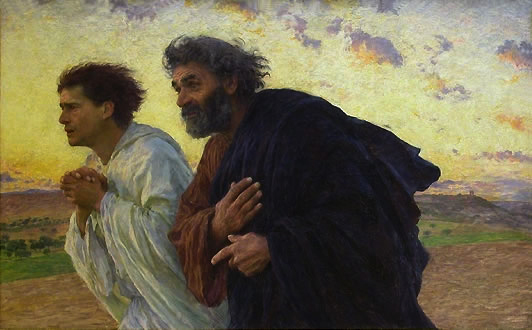
Robert Browning, the Victorian poet of the 19th century, is mainly remembered today for his fascinating dramatic monologues like My Last Duchess, and his marriage to Elizabeth Barrett Browning, who was the more famous poet at the time they married. Browning became a formidable poet in his own right, and is nearly always included in contemporary anthologies of English Literature, as is his wife.
What is often forgotten about Browning today is the seriousness of his Christian faith, and his response to some of the intellectual challenges to belief in his day. In fact, a generation or so after his death, Edward Berdoe, a member of the Royal College of Surgeons, wrote a book called Browning and the Christian Faith because Browning had literally saved his belief in Christ. As he read works on agnosticism, Berdoe had abandoned Christianity and embraced Buddhism. Later he heard a lecture on Browning’s poetry and was so fascinated, he bought a set of Browning’s complete works. As he read Saul, Paracelsus, and A Death in the Desert, among others, he came back to his Christian faith.[1]
Browning was well-read and conversant in the issues of the day, including German Higher Criticism, which was seen by many as an attack on the historic Christian faith. German theologians were attacking Moses’ authorship of the Pentateuch and the historicity of the Gospels, among other things.
It was in this milieu that Browning wrote “A Death in the Desert,” which is mainly a monologue by the Apostle John at the end of his life. The question Browning raises in the poem is: How will succeeding generations believe in Christ after John, the last of the eyewitnesses dies? “How will it be when none more saith, ‘I saw’?” (line 133).
Browning uses the motif of sight to explore these questions, deftly moving from John’s literal sight as he witnessed Jesus’ miracles, to the spiritual sight of those who, not having the advantage of seeing Jesus themselves, are nevertheless captured by his love.
Throughout most of the poem, John speaks of his beliefs and experiences. In the first section he discusses himself as an eyewitness to what Jesus said and did: “‘It was so; so I heard and saw,’/ Speaking as the case asked: and men believed.” (137-38). Later he declares, “Ye needs must apprehend what truth/ I see, reduced to plain historic fact’” (235-36). John repeatedly taught and wrote the message of the miracles and teaching he witnessed.
But interestingly, he admits this was not enough, even for him. Though John had seen the miracles of Christ, “Christ’transfigured,” he cowered under Roman persecution, “forsook and fled” because he saw “sudden Roman faces, violent hands” (304, 310, 308). Thus, Browning declares that although seeing Jesus’ miracles bolstered faith, they were not the ultimate solution to the problem of doubt. He establishes the theme of physical sight as a foundation for the beginnings of Christianity, but not a solution to the doubts of a new generation, full of “youth and strength” that will ask “’Was John at all, and did he say he saw?” (199, 196).
John moves on to say it is a spiritual sight, an experience of the Love of Christ, that will replace eyewitness testimony as the apologetic of a new generation who didn’t know the apostles. He describes “[Jesus’] love, at issue still with sin” as “truth, breaking bounds” which “o’erfloods my soul” (212, 217). Browning eloquently describes the power of this love, taking over for a new generation, in the words of John:
I saw the power; I see the Love, once weak,
Resume the Power: and in the word “I see,”
Lo, there is recognized the Spirit of both
That moving o’er the spirit of man, unblinds
His eye and bids him look’[2]
Here the “power” of argument behind miracles gives way to the “Power” of “Love” revealed in spiritual sight, the “unblinding” of the Spirit. This sight would overwhelm, in an age where “truth, deadened of its absolute blaze,/ Might need love’s eye to pierce the o’erstretched doubt” (320-21).
At the end, Browning appeals to his hearers to follow this Love. “For see; Himself conceived of life as love/ Conceived of love as what must enter in’Call Christ, then, the illimitable God, or lost!” (670-71, 686-87). All this in reaction to German Higher Criticism, the question of the Victorian age: “Must Christ then be?/ Has He been? Did we not ourselves make Him?” (376-77). Browning’s answer is at once eloquent and intricate. A fine apologetic for the Victorian mind.
Notes
[1] Kenmare, Dallas. An End to Darkness. Peter Owen: London, 1962, p. 190.
[2] Lines 221-25.
For Further Reading
Browning, Robert. “A Death in the Desert.” In The Works of Robert Browning, with introductions by Sir F.G. Kenyon. Vol IV. Barnes and Noble, 1966, pp. 270-291.
Kenmare, Dallas. An End to Darkness. London: Peter Owen Limited, 1962.
Kenmare, Dallas. Ever a Fighter: A Modern Approach to the Work of Robert Browning. London: James Barrie, 1952.
Image Credit
Burnand, Eugène, 1850-1921. Disciples John and Peter on their way to the tomb on Easter morning, from Art in the Christian Tradition, a project of the Vanderbilt Divinity Library, Nashville, TN. http://diglib.library.vanderbilt.edu/act-imagelink.pl?RC=55038 [retrieved May 6, 2016]. Original source: http://commons.wikimedia.org/wiki/File:BurnandJeanPierre.jpg.
Mark is on staff with InterVarsity Christian Fellowship in Manhattan, Kansas, where he ministers to Faculty at Kansas State University and surrounding campuses. He has been in campus ministry 25 years, 14 of those years in faculty ministry. He has a Master’s degree in philosophy and theology from Talbot School of Theology, La Mirada, CA, and is passionate about Jesus Christ and the life of the mind. Mark, his wife and three daughters make their home in Manhattan.

It is too bad Browning’s faith is often overlooked in academia. How anyone could even attempt to understand his poetry without appreciating his Christian beliefs is beyond me.